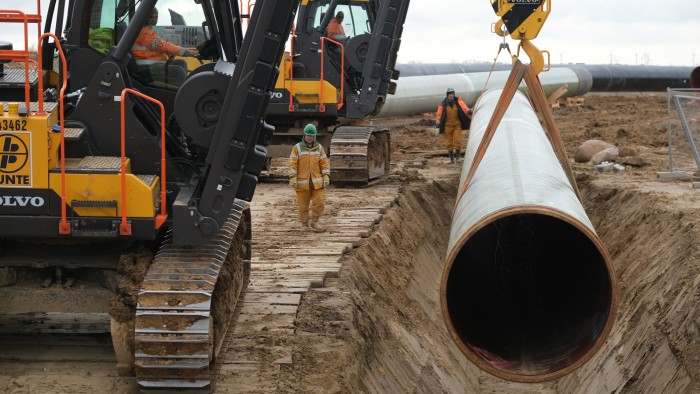European crisis risks climate action reputation


Simply sign up to the Climate change myFT Digest -- delivered directly to your inbox.
The events of the past year have radically altered Europe’s energy policy. The goal of achieving net zero before 2050, confirmed 12 months ago at the COP26 meeting in Glasgow, is still in place. But the immediate priority across Europe, now, is to secure energy supplies for the coming winter and to mitigate the economic and social impact of dramatic increases in oil and gas prices.
The short-term responses — extensions of the use of coal and the search for new local and imported sources of natural gas — might suggest that the climate agenda set in Glasgow has been abandoned. However, that is not the case. If anything, energy is now a much more immediate political concern than it was a year ago.
The energy crisis sparked by Russia’s invasion of Ukraine has certainly provided a sharp reminder to European consumers, and governments, that hydrocarbons still provide more than 80 per cent of the continent’s energy needs.
But the sudden turn of events has also made the risks of reliance on hydrocarbon imports glaringly evident. As a result, the prospect of shifting to low-carbon sources of supply has become more attractive.
Wind and solar are, for now at least, both cheaper providers of electricity than imported gas. Using power produced locally also reduces the discomfort of dependence on unreliable trading partners. The energy transition and the cause of energy security have merged into one.
Not surprisingly, the growth of investment in wind and solar supplies of electricity is the dominant trend.

Previously seen as a “bridge” to a lower carbon economy — as it is a less polluting fossil fuel than coal and oil — gas is regarded as the principal source of energy insecurity and has become the primary target of the transition agenda.
Demand for it cannot be eliminated quickly because the infrastructure of energy consumption from home heating systems to industrial plants is entrenched. Even so, total consumption has fallen. In the second quarter of this year, Europe used 16 per cent less natural gas than a year earlier. That level is set to fall further.
In the short term, new LNG facilities being built in the US and the Middle East will provide additional supplies to fill the immediate gap. But, in a shrinking market, Russia will struggle to regain its dominant role as a supplier even if the war in Ukraine ends soon.
More stories from this report
‘Loss and damage’ debate set to dominate the COP27 agenda
Watchdogs call for rules to come clean on green finance claims
Cairo sets agenda for ‘the African COP’ at Red Sea resort
‘Loss and damage’ stalemate has reached breaking point
Why act now? Look at the natural disasters around you
Media have big responsibility in the age of global warming
UK’s green hydrogen ambitions fail to deliver
Fusion edges from fantasy to reality
A new, lower carbon energy mix is therefore emerging in Europe — but at some cost to the wider ambitions of the COP26 agenda. The urgency of the situation over the past six months has led to a reassertion of national control of energy policy. Governments liable to be judged by their ability to keep the lights on and to protect consumers from soaring prices cannot afford to wait for consensus across 28 countries, let alone for a global deal.
Proposals from the European Commission for price caps and common purchasing arrangements have been hindered by the need to move at the pace of the most reluctant member state. In Germany, in particular, national support packages — securing supplies and protecting consumers with price subsidies — have transcended efforts to find pan-European solutions.
The focus of national policies is internal and the cost is high. Thanks to Covid and energy support packages, government debt across the EU has risen to over 90 per cent of GDP — and will be pushed higher by new packages being put in place. Rising bond rates are adding to the costs of servicing the borrowing. In a climate characterised by inflation and austerity, there is little prospect of any serious response to the cries from emerging economies for climate justice. Nor, too, can we expect a rush to provide the new funding for energy transition in the world’s poorer countries that will be demanded at COP27 in Sharm el-Sheikh.
The mood in Europe is one of protectionism — a determination to protect Europe’s industrial base from the risks of high energy costs and supply interruptions. The levers of this protectionism range from the Carbon Border Adjustment Mechanism, which will put tariffs on imports from countries not meeting European climate standards, to maximising locally produced energy supplies — which, in the short term, will include fossil fuels.
A period of low economic growth or, in some countries, recession, can only reinforce the trend. This approach could trigger an open trade conflict with countries such as India, which resents Europe’s unwillingness to accept that emerging economies still produce far fewer emissions per capita than the EU. And such conflicts, unfortunately, will hinder attempts to reach new and tighter agreements on the climate agenda.
The good news is that Europe will probably lower its emissions more rapidly than could have been expected a year ago. The bad news is that, for the moment, little progress is likely on global deals.
Climate policy remains an important focus for leaders across the continent. Optimists can only hope that, once economic stability is restored, they will realise that delivering a clean Europe in a dirty world achieves nothing.
The author is visiting professor and former chair of the Kings Policy Institute at King’s College London
Climate Capital

Where climate change meets business, markets and politics. Explore the FT’s coverage here.
Are you curious about the FT’s environmental sustainability commitments? Find out more about our science-based targets here
Comments